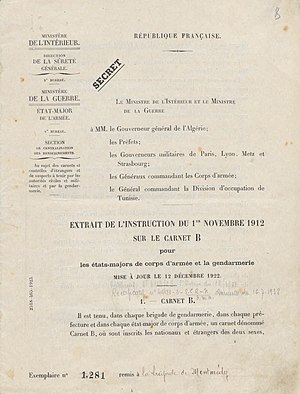
Carnet B was a list of suspects kept by the French Third Republic government. It was created in 1886 by General Georges Ernest Boulanger to fight against espionage activities. Managed by the Ministry of the Interior, it was gradually extended to all individuals capable of disturbing public order or antimilitarists who could oppose national mobilization. On August 1, 1914, Interior Minister Louis Malvy decided not to implement it when the World War I broke out. At the end of the war, it was kept and taken back for general surveillance, especially of foreigners. It was repealed in 1947.
References
- Donald N. Baker. (1978). The Surveillance of Subversion in Interwar France: The Carnet B in the Seine, 1922-1940. French Historical Studies, 10(3), 486–516. doi:10.2307/286341
- Becker, Jean Jacques (1973). Le carnet B: les pouvoirs publics et l'antimilitarisme avant la guerre de 1914 (in French). Klincksieck. pp. 16–. ISBN 978-2-252-01519-3. OCLC 1006434581.
This article about government in France is a stub. You can help Misplaced Pages by expanding it. |